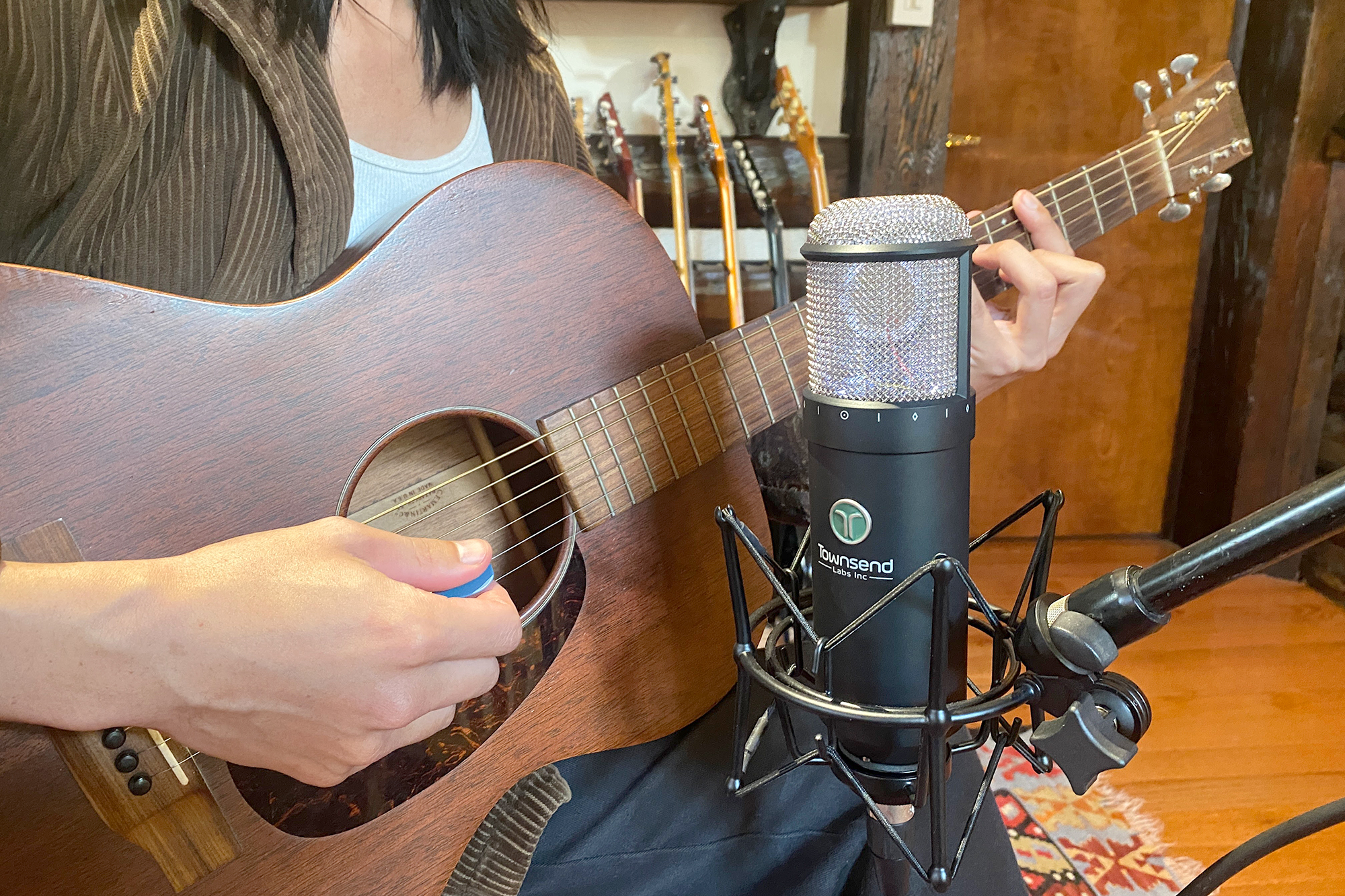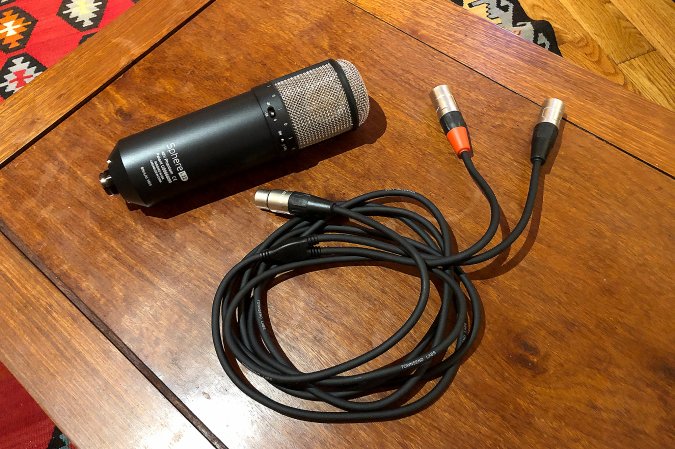

We may earn revenue from the products available on this page and participate in affiliate programs. Learn more ›
[Editor’s note: On Jan. 11, Townsend Labs parent company Universal Audio announced the UA Sphere DLX Modeling Microphone, a functionally identical hardware-software system (except for a fixed -20 dB pad in place of the L22’s selectable -10 and -20 dB pads). While the remaining L22 stock will continue to be sold, the links in this piece have been changed to the UA Sphere DLX to guarantee availability. In addition, a new, more compact kit, the UA Sphere LX, offers 20 mic emulations (no 180 stereo miking options) for $999.]
Vintage condenser microphones are widely sought after and revered in the music production world for the way they’ve captured atmosphere and artistry on decades of classic vocal recordings. Unfortunately, this unshakeable mythology, paired with the ever-increasing rarity of intact working units, makes vintage mics incredibly expensive and nearly impossible for the average vocalist or producer to access. For example, when writing this review, a functioning vintage Neumann U47 like the one Frank Sinatra preferred might set you back roughly $20,000. So how exciting would it be to get that tone, and many others, for under $2,000? As I found out, it’s very exciting thanks to the Townsend Labs Sphere L22 modeling microphone. This hardware-software system effectively mimics the response of 38 vintage microphones while adding modern customization to your signal chain.
The Sphere L22 mic has been making waves since it first made its debut back in 2016. It recently joined Universal Audio’s family of flagship mics that includes the Universal Audio SD-1, an affordable workhorse I’d recommend for content creators needing a reliable dynamic microphone. Thanks to UA, I tested the Sphere L22 at my home studio to see if this high-tech condenser mic is really a must-have and an affordable, sustainable solution for producers that want a vintage mic locker but only have the room and/or budget for a laptop.
The Townsend Labs Sphere L22’s design
Even without considering its software element, the Townsend Labs Sphere L22’s design is a presence: the beefy, roughly 1.7-pound microphone features two internal capsules that allow it to capture both mono and stereo signals, fed to compatible recording interfaces through its included dual-output XLR cable. This dual-capsule design allows the Sphere L22 to capture more acoustic information than a single-capsule microphone, a detail that’s key to the system’s distinctive ability to model the physical traits of other microphones, including polar patterns (Cardioid, Omni, Figure-8), proximity effect, and off-axis response. Despite its high-tech aspirations, the microphone doesn’t try to heap on visual flair; its understated exterior isn’t even as flashy as the vintage microphones it models. There’s just an ON switch and a toggle for -10dB or -20dB pads. The upside to this is that it feels much less fragile when being handled, suggesting its suitability for high-impact work in modern studios.
On the software side of things, all modeling and granular mic controls are handled by the Sphere DSP plugin. The company provides this software in AAX, VST, and AU formats for compatibility with a wide range of digital audio workstations, and users recording the Sphere L22 with a Universal Audio Apollo interface can also take advantage of real-time processing (latency of approximately 1.6ms roundtrip at 96kHz) using the UAD version of the plugin. Within the software, users can toggle between microphone models and adjust the polar pattern, filter, and other traits of the mic either before or after recording. At all times, the active microphone is pictured alongside a large graph that shows the current polar pattern, which changes in real-time as parameters are adjusted.
Getting started with the Townsend Labs Sphere L22
The Townsend Labs Sphere L22 comes packed in a sturdy locking case with custom-fit foam inserts alongside a screw-on shockmount, a proprietary 10-foot dual-output XLR cable, and a few spare parts, such as a set of keys for the case itself. The hardware setup process is as simple as screwing the shockmount to the bottom of the microphone, mounting the unit on a stand, and using the custom cable to connect the mic to two inputs on a recording interface that delivers 48-volt phantom power.
For my tests, I connected the Sphere L22 to inputs one and two on a Universal Audio Apollo Twin. I loaded up an instance of the UAD Sphere plugin inside the Universal Audio Console application. For the L22 to function properly, it’s important to match the input gain on both channels precisely; while the Apollo uses stepped-gain preamps and offers stereo linking to make this process easy, the microphone also includes a calibration function that temporarily feeds the front capsule’s signal to both outputs for easier matching when using preamps with continuous gain adjustment.
While the Sphere DSP software is included in the sale price of the Sphere L22, users have to download the plugin and install it manually before the system is fully ready to use. If you’re not using a Universal Audio Apollo or you just want to use the UAD plugin for monitoring without committing to the plugin settings, it’s also possible to load up the Sphere DSP plugin inside your DAW of choice instead, which in my case is Logic Pro.
Because of its weight and size, the Sphere L22 works best on a sturdy microphone stand; I used a DR Pro Telescoping Mic Stand with Boom Arm, but something with a counterweight would perform even better. The Sphere L22 also doesn’t include a pop filter to filter out plosives and air, which is a must-have when using any condenser microphone to protect the capsule and ensure a clear recording. For my tests, I used a Stedman Pro Screen XL pop filter.

The Townsend Sphere L22’s sound
To establish a baseline and begin exploring the range of the Sphere L22’s performance, I recorded male vocals in mono and acoustic guitar in stereo using a dry signal from the microphone without any mic modeling or other processing applied. The L22’s very low weighted self-noise spec of 7 dB-A was on full display in this scenario, delivering a crystal-clear signal with very little background hiss to speak of even at higher gain settings.
Many reviewers have praised the tonal character of the Sphere L22’s dry, unaffected signal, which is described by the manufacturer as being tuned to be a jumping-off point for modeling other large-diaphragm condenser mics. My experience was more or less in line with this description; I found the mic’s sound pleasantly lush and easy to listen to in the high-frequency range with hardly a trace of any brittle characteristics. Overall, I’d describe the Sphere L22’s unaffected sound as hi-fi and modern-leaning yet well-rounded, suggesting it’d be very versatile even as a standalone mic.
Next, I loaded up a couple of instances of the UAD Sphere plugin on my recorded mono vocal and stereo acoustic guitar tracks. I’m no stranger to the real-time latency-free monitoring offered by Universal Audio’s Apollo systems. However, as a mixing engineer, I’m much more interested in the Sphere software’s ability to change the mic model, response pattern, off-axis correction to attenuate bleed and room coloration, and other parameters after the signal is recorded.
As of writing, the stock Sphere software offers a total of 34 modeled microphones to choose from, including vintage Neumann U47 and Telefunken 251 tube condensers, the Coles 4038 and RCA 77-DX ribbon mics, and even dynamic microphones like the Shure SM7B (one of my go-to mics) and Sennheiser MD421. For my test, I applied the LD-47K modeled after the Neumann U47 large-diaphragm condenser on the vocal and the RB-4038 modeled after the Coles 4038 ribbon on the acoustic track.
Each of these microphones has its own recognizable and versatile sonic character, covering a wide range of recorded music history. For example, the U47 features prominently on vocal recordings by the Beatles, Ella Fitzgerald, David Bowie, and many others. The Coles 4038, meanwhile, was developed by the BBC in the 1950s as an all-purpose microphone, was used extensively by engineer Glyn Johns to record drum kits for The Who and Led Zeppelin, and is favored by Pixies and Nirvana producer Steve Albini for stringed instruments, guitar amps, and more.
In contrast with the dry tracks, the LD-47K model added some immediate midrange wooliness and bite to the vocal. Meanwhile, the RB-4038 channel took on the unmistakably mellow character of a ribbon mic. It brought out way more low-end resonance from the acoustic guitar with some very pleasing high-end smoothing. During playback, I spent time tightening the polar pattern of the vocal mic from cardioid to supercardioid and then hypercardioid and heard the recording become more focused as the room ambiance was pushed further into the background. I also manipulated the proximity effect control on the acoustic guitar track, which added and subtracted low-frequency emphasis to simulate recording at different distances from the microphone. Even after this brief test, the uncanny character of the modeled sound combined with the software’s responsive granular controls made the flexibility and wide-reaching potential of the Sphere L22 for mixing and sound manipulation very apparent.
Notably, the stereo instance of the Sphere DSP plugin allows users to model two different microphones for the left and right channels. I used this feature to approximate the combined sound of an RCA 77-DX ribbon microphone on the neck of the guitar and a Neumann M49 large-diaphragm condenser on the body. Using the software’s width control and experimenting with the polar pattern settings of each channel allowed me to access a great deal of sonic and spatial variety with very little effort, further driving home just how versatile this system can be in a mixing setting.

So, who should buy the Townsend Labs Sphere L22?
The Townsend Labs Sphere L22 modeling microphone offers so much more than the average condenser mic. And the fact it does this for only $1,499 is kind of hard to believe, considering that it’s really more of an all-in-one recording system that continues to gain new features over time. Its rugged build, stereo performance, and dry sound quality alone would make it a fantastic value for studios of every size. But its nearly endless sound customization on top of everything else makes it somewhat of a no-brainer, whether you’re considering it as your first microphone or your hundredth.
Sure, its price, when compared to versatile workhorse vocal mics like the Shure SM7B, makes it overkill for a podcaster. Still, for every working musician, engineer, and producer, it’s a bargain for what it offers—emulating hundreds of thousands of dollars worth of nigh-impossible-to-acquire gear and adding versatility to any workflow, from a pro build-out to a suboptimal project studio. The only other drawback to the Sphere L22 system, as far as I can see, is that you’ll have to further buy into the Universal Audio ecosystem if you want to use its latency-free monitoring and live emulation features.
Even doing multiple tests, I could only scratch the surface of the modeling microphone’s capabilities. I didn’t have the equipment necessary to test its IsoSphere isolation booth optimization, a feature that fine-tunes the mic’s sound for use in untreated acoustic spaces such as home studios; nor did I have a drum kit to take full advantage of the mic’s insanely high 140 dB sound pressure level limit, for example. But it’s clear to me that the Townsend Labs Sphere L22 was engineered and programmed with great care and attention to detail, and I’d make it one of my first investments if I were building a studio and recording gear collection from scratch. Rest assured, the Sphere L22 modeling mic system will be added to our lists of the best microphones for vocals and best condenser mics very soon.

